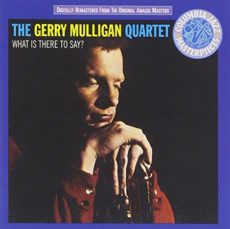
Daily Dose Of Jazz…
Gerry Mulligan was born Gerald Joseph Mulligan on April 6, 1927 in Queens Village, Queens, New York. His father’s career as an engineer moved them frequently through numerous cities and while less than a year old, the family moved to Marion, Ohio. Taking on a nanny to help raise the children, Lily rose became fond of Gerry and he spent time at her home and became enamored with her player piano that had amongst it collection of rolls, Fats Waller. Her home was also a boarding house for Black musicians who came through town giving him the chance to meet them..
During a family move to Kalamazoo, Michigan he took up the clarinet in the Catholic school’s orchestra and made an attempt to arrange the Richard Rodgers song Lover. By 14 he was in Reading, Pennsylvania studying clarinet with dance-band musician Sammy Correnti, who encouraged his arranging. During this period Mulligan began professionally playing the saxophone in dance bands in Philadelphia, Pennsylvania, which was the family’s next move.
He attended the West Philadelphia Catholic High School for Boys, organized a school big band, and wrote arrangements and by 16 was selling arrangements to local radio station WCAU. Dropping out of high school during his senior year he worked with a touring band Tommy Tucker, picking up a $100.00 a week for two or three arrangements.
A move to New York City in 1946 saw Gerry joining the arranging staff on Gene Krupa’s bebop-tinged band pumping out arrangements of Birdhouse, Disc Jockey Jump and How High the Moon” that quoted Charlie Parker’s “Ornithology” as a countermelody. He began arranging for the Claude Thornhill Orchestra, along with Gil Evans and occasionally sitting in as a member of the reed section.
In September 1948, Miles Davis formed a nine-piece band that featured arrangements by Mulligan, Evans and John Lewis that ended up on the Capitol Records album, titled Birth of the Cool. The band initially consisted of Davis on trumpet, Mulligan on baritone saxophone, trombonist Mike Zwerin, alto saxophonist Lee Konitz, Junior Collins on French horn, tubist Bill Barber, pianist John Lewis, bassist Al McKibbon and drummer Max Roach. The Davis nonet has been judged by history as one of the most influential groups in jazz history, creating a sound that, despite its East Coast origins, became known as West Coast Jazz.
Throughout the late Forties and early Fifties he worked with Davis, George Auld, Chubby Jackson and led his debut as a leader with Mulligan Plays Mulligan. By 1952 he was moving to Los Angeles, California and arranging for Stan Kenton and getting a recording contract with Pacific Jazz Records. These sessions enlisted trumpeter Chet Baker as part of his pianoless quartet that included bassist Bob Whitlock and Chico Hamilton on drums.
Valve trombonist Bob Brookmeyer would replace Baker, and Mulligan and Brookmeyer both occasionally play piano, would enlist Jon Eardley, Art Farmer, Zoot Sims, Al Cohn, Lee Konitz and Annie Ross. He performed as a soloist or sideman with Paul Desmond, Duke Ellington, Ben Webster, Johnny Hodges, Jimmy Witherspoon, André Previn, Billie Holiday, Marian McPartland, Louis Armstrong, Count Basie, Stan Getz, Thelonious Monk, Fletcher Henderson, Manny Albam, Quincy Jones, Kai Winding and Dave Brubeck, to name a few. Mulligan appeared in Art Kane’s A Great Day in Harlem portrait of 57 major jazz musicians taken in August 1958.
Gerry appeared in the films Follow That Music, I Want to Live!, Jazz on a Summer’s Day, The Rat Race, The Subterraneans and Bells Are Ringing and wrote music for A Thousand Clowns, Luv, La Menace, and Les Petites galères and I’m Not Rappaport.
Baritone saxophonist, clarinetist, composer and arranger Gerry Mulligan passed away on January 20, 1996 in Darien, Connecticut at the age of 68, following complications from knee surgery. He had won numerous awards not limited to Down Beat Poll Winners, Kennedy Center Honors, and a Grammy Award for Best Jazz Instrumental Performance by a Big Band for Walk on the Water.
Sponsored By
#preserving genius
More Posts: saxophone


